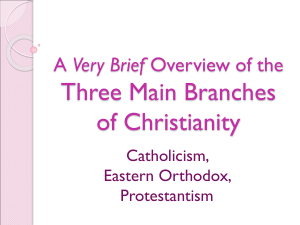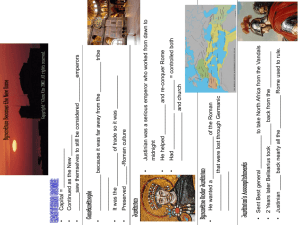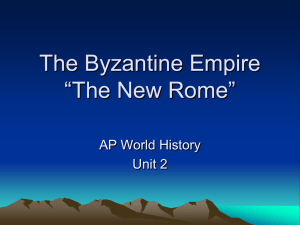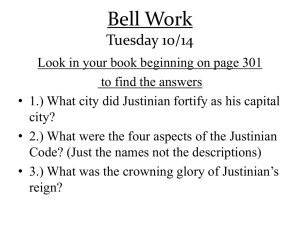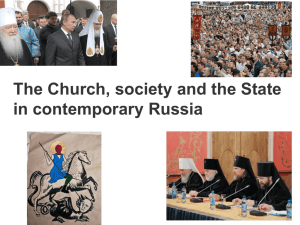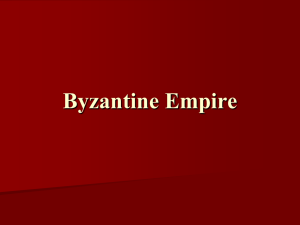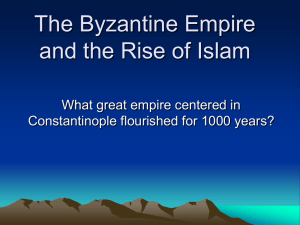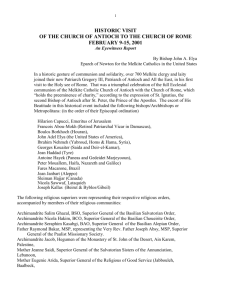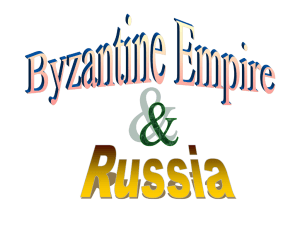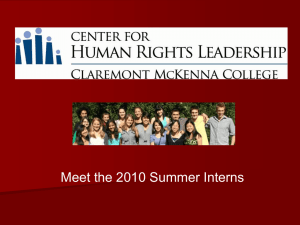Byzantines, Russians, and Turks Interact 500-1500 AD
advertisement
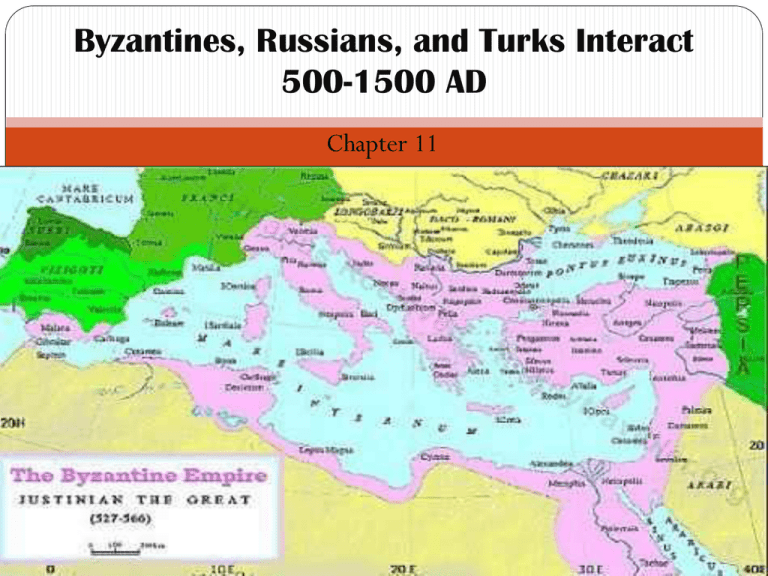
Byzantines, Russians, and Turks Interact 500-1500 AD Chapter 11 Vocabulary Justinian Code: The Body of Roman Law, collected and organized by the Byzantine Emperor Justinian Hagia Sophia: The Cathedral of (Holy Wisdom in Constantinople) built by Justinian Patriarch: Principal Bishop in the Eastern Branch of the Christianity (Eastern Orthodox) Icon: A religious image used by Eastern Orthodox Christians Excommunication: The taking away of a person’s right of membership in a Christian Church Vocabulary Cyrillic Alphabet: The alphabet for “Slavic” languages Slavs: People from the forests North of the Black Sea (Now Eastern European) Ivan III: Russian who established the Russian control from the Mongols Czar: Russian emperor (Roman title for Caesar) Seljuks: Turkish group who started their own empire in Turkey in the 11th century Malik Shah: Most famous Seljuk sultans/prime minister Byzantium Becomes the New Rome New Rome in a New Setting Justinian: A New Line of Caesars Rome was officially divided in two in 395 Justinian became Caesar of the Eastern Roman Empire in 527 The Absolute Power of the Emperors The Byzantine Emperors controlled politics and religion Building the New Rome Justinian’s Code The Code consisted of four works aimed at created a uniform set of laws for Byzantium a. The Code - Contained 5,000 Roman Laws b. The Digest – Summarized the opinions of Rome’s legal thinkers c. The Institutes – A Textbook that taught students about the laws d. The Novellae – Any new laws created after 534 Strange Laws Building A New Rome Creating the Imperial Capital Justinian rebuilt massive fortifications around Constantinople Construction of hospitals, aqueducts, and schools rivaled old Rome Hagia Sophia (Holy Wisdom)/Hippodrome Reconquered most of the OLD ROMAN EMPIRE!!!!! Constantinople’s Hectic Pace The City’s main streets were crowded with merchants from Asia, Africa, and Europe Free entertainment provided at the Hippodrome (horse-track) which sat 60,000 people Hippodrome Life In The New Rome Byzantium Preserves Learning Schools and Subjects Almost all children attended either monastic or public schools Byzantium helped to preserve ancient Greek and Roman knowledge through the Middle Ages The Empire Confronts Its Enemies The Mysterious Plague of Justinian From 542-700 a series of plagues swept through Byzantium By 700, Byzantium had lost a large amount of its population Attacks On The Empire Attacks From East and West Germanic tribes, Seljuk Turks, and Russians launched invasions of Byzantine territory between 600-1400 Constantly attacked due to resources/trade routes By 1350, only immediate area around Constantinople was controlled by Byzantium The Division of Christianity The Church Divides A Split Between Rome and Constantinople The head of the Eastern Church was known as the Patriarch In 1054, the Patriarch and the Pope had a disagreement over religious doctrine Each excommunicated the other, or kicked them out of the church The Great Schism, it forever split Roman Catholicism with Eastern Orthodox Division of Christianity Roman Catholic Eastern Orthodox Old New Pope Patriarch Rome Constantinople Roman Catholic Similarities Old Eastern Orthodox New Latin They base their faith on the gospel of Jesus and the Bible Greek or local languages The Pope has authority over all other Bishops They use sacraments such as a baptism The Patriarch and other bishops head the Church as a group The Pope claims authority over all kings and emperors Their religious leaders are Priests and Bishops The emperor claims authority over the Patriarch and other Bishops the empire Priests may not marry Divorce is not allowed Priests may be married They seek to convert people Divorce is allowed under certain conditions Roman Catholic Old Eastern Orthodox New Similarities Language Latin Greek or local languages They base their faith on the gospel of Jesus and the Bible Religious Structure The Pope has authority over all other Bishops The Patriarch and other bishops head the Church as a group They use sacraments such as a baptism The emperor claims authority over the Patriarch and other Bishops the empire Their religious leaders are Priests and Bishops Authority: The Pope claims authority over all Political kings and emperors Priests Priests may not marry Priests may be married Divorce Divorce is not allowed Divorce is allowed under certain conditions They seek to convert people Religious Conversations Byzantine Missionaries Convert the Slavs Missionaries from the Orthodox Church began to convert Slavs in the 9th Century Cyrillic Alphabet Basis for Slav/Russian Lang. Cyrillic Language Chapter 11:2 The Russian Empire Russians Adapt Byzantine Culture Both Slavic and Greek The Land of Russia’s Birth Three great rivers (Dnieper, Don, and Volga) connect Russia to the Black and Caspian Seas Ural Mountains Slavs and Vikings The original inhabitants of Eastern Europe were a mix between Slavs and Vikings Vikings called Rus (Russia) Slaves invited Viking King (Rurik) to be their king The Birth of Russia Kiev Becomes Orthodox Kiev become powerful trade city (Constantinople) Prince Vladimir Investigates Monotheism Prince Vladimir converted to Orthodox Christianity in 989, and made it the official religion of Kiev Created link between Kiev and Byzantine Empire Kiev’s Power and Decline Kiev due to trade with Constantinople (Educated, Prosperous) Kiev held great power in 11th century, led by great Kievan ruler: Yaroslav the Wise Married off daughters for political power/alliances After his death, civil war and crusades disrupted prosperity Mongolian Invasion Mongol Invasions Favor the Rise of Moscow Mongol Rule in Russia In 1240, Mongol warriors destroyed Kiev, slaughtering most inhabitants Khanate Golden Horde (Kingdom, Royal Color Camp) Mongols allowed Russians to keep their customs in return for obedience and monetary tribute Mongol rule cut off the Russians from Western Europe, setting them back 200 years in technology Life Under The Mongols 1. Allowed to continue culture/religion (tax) 1. Mongol Demands: “Absolute Obedience/Massive Tributes” 2. Religious toleration 3. Separated from Western Europe/Isolated (No new Technology/Cultural Diffusion) 4. Moscow became center of Russian government under Mongols 5. Patriarch of Eastern Church moved to Moscow, linking religion with government Russia Breaks Free By 1156 Moscow grew to be an important city (Volga, Dnieper, Don Rivers) Prince Ivan I grew in power b/c tax collector Convinced the Patriarch in Kiev to move to Moscow Church now supported Moscow Ivan III: 43 year reign Challenged Mongol Rule, named himself “Czar” Marched to battle but both sides turned around (Bloodless Revolution) Chapter 11:3 Turkish Empires Rise In Anatolia Rise of the Turks Nomadic Herders Known for their military skill/craftsmanship Abbasids bought Turkish child-slaves to train as soldiers (Mamelukes) Seljuk Turks (family/clan) grew in power Captured the Abbasid capital (Baghdad) in 1055 AD Captured Persia Adopted Religion, language, literature Shah (king) Eventually pushed their forces into Anatolia Pressured the Byzantine Empire Challenges Facing the Seljuk The Seljuk and the Crusaders Pope II launched the First Crusade in 1095 Christians to drive the Turks/Muslims out of Anatolia/Holy Land 1099 the Crusaders captured Jerusalem (Massacred Jewish/Muslims) Saladin lead Muslims recaptured Jerusalem 1187 The Seljuk Face the Mongols Mongol Armies eventually turned to the West Destroyed/Conquered/slaught ered everything in the way Captured Baghdad Wrapped the Caliph in blankets (Horses)
